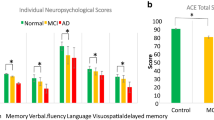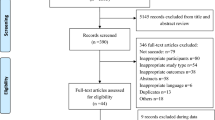Abstract
Saccadic impairment in Alzheimer’s disease (AD) was found in horizontal saccades. The present study extends investigation to vertical saccades in a large number of subjects, including AD and amnestic mild cognitive impairment (aMCI). We examined both horizontal and vertical saccades in 30 healthy elderly, 18 aMCI, and 25 AD. Two tasks were used: gap (fixation target extinguishes prior to target onset) and overlap (fixation stays on after target onset). Eye movements were recorded with the Eyeseecam system. (1) Robust gap effect (shorter latencies in gap than in overlap) exists for AD and aMCI patients as for healthy elderly; (2) abnormal long latency of saccades in gap and overlap tasks for AD relative to healthy elderly and aMCI patients; (3) longer latency for aMCI patients than for healthy elderly for the overlap task; (4) significant correlation between scores of Mini-Mental State Examination (MMSE) and latencies of saccades considering the AD group only; (5) higher coefficient of variation in latency for AD patients than for healthy elderly and for aMCI patients; (6) variability of accuracy and speed is abnormally higher in AD patients than in aMCI and healthy elderly. Abnormalities of latency and latency–accuracy–speed variability reflect deficits of cerebral areas involved in the triggering and execution of saccades; latency of saccades can be used as follow-up test for aMCI and AD patients with its significant correlation with the changes of MMSE scores.





Similar content being viewed by others
References
Abel LA, Unverzagt F, Yee RD (2002) Effects of stimulus predictability and interstimulus gap on saccades in Alzheimer's disease. Dement Geriatr Cogn Disord 13(4):235–243
Andersen RA, Mountcastle VB (1983) The influence of the angle of gaze upon the excitability of the light-sensitive neurons of the posterior parietal cortex. J Neurosci 3(3):532–548
Bizzi E (1968) Discharge of frontal eye field neurons during saccadic and following eye movements in unanesthetized monkeys. Exp Brain Res 6(1):69–80
Boxer AL, Garbutt S, Rankin KP, Hellmuth J, Neuhaus J, Miller BL, Lisberger SG (2006a) Medial versus lateral frontal lobe contributions to voluntary saccade control as revealed by the study of patients with frontal lobe degeneration. J Neurosci 26(23):6354–6363. doi:10.1523/JNEUROSCI.0549-06.2006
Boxer AL, Geschwind MD, Belfor N, Gorno-Tempini ML, Schauer GF, Miller BL, Weiner MW, Rosen HJ (2006b) Patterns of brain atrophy that differentiate corticobasal degeneration syndrome from progressive supranuclear palsy. Arch Neurol 63(1):81–86
Brun A, Englund E (1981) Regional pattern of degeneration in Alzheimer's disease: neuronal loss and histopathological grading. Histopathology 5(5):549–564
Bylsma FW, Rasmusson DX, Rebok GW, Keyl PM, Tune L, Brandt J (1995) Changes in visual fixation and saccadic eye movements in Alzheimer's disease. Int J Psychophysiol 19(1):33–40
Crawford TJ, Higham S, Renvoize T, Patel J, Dale M, Suriya A, Tetley S (2005) Inhibitory control of saccadic eye movements and cognitive impairment in Alzheimer's disease. Biol Psychiatry 57(9):1052–1060
Dorris MC, Pare M, Munoz DP (1997) Neuronal activity in monkey superior colliculus related to the initiation of saccadic eye movements. J Neurosci 17(21):8566–8579
Findlay JM, Walker R (1999) A model of saccade generation based on parallel processing and competitive inhibition. Behav Brain Sci 22(4):661–674, discussion 674–721
Fischer B, Breitmeyer B (1987) Mechanisms of visual attention revealed by saccadic eye movements. Neuropsychologia 25(1A):73–83
Fischer B, Weber H (1993) Express saccades and visual attention. Behav Brain Sci 16:553–610
Folstein MF, Folstein SE, McHugh PR (1975) “Mini-mental state”. A practical method for grading the cognitive state of patients for the clinician. J Psychiatr Res 12(3):189–198
Garbutt S, Matlin A, Hellmuth J, Schenk AK, Johnson JK, Rosen H, Dean D, Kramer J, Neuhaus J, Miller BL, Lisberger SG, Boxer AL (2008) Oculomotor function in frontotemporal lobar degeneration, related disorders and Alzheimer's disease. Brain 131(Pt 5):1268–1281
Goldberg ME, Bruce CJ (1981) Frontal eye fields in the monkey: eye movements remap the effective coordinates of visual stimuli. Society for Neuroscience 7:131
Hershey LA, Whicker L Jr, Abel LA, Dell'Osso LF, Traccis S, Grossniklaus D (1983) Saccadic latency measurements in dementia. Arch Neurol 40(9):592–593
Hoffman JE, Subramaniam B (1995) The role of visual attention in saccadic eye movements. Percept Psychophys 57(6):787–795
Hutton JT, Nagel JA, Loewenson RB (1984) Eye tracking dysfunction in Alzheimer-type dementia. Neurology 34(1):99–102
Isa T, Kobayashi Y (2004) Switching between cortical and subcortical sensorimotor pathways. Prog Brain Res 143:299–305
Kapoula Z, Isotalo E, Muri RM, Bucci MP, Rivaud-Pechoux S (2001) Effects of transcranial magnetic stimulation of the posterior parietal cortex on saccades and vergence. Neuroreport 12(18):4041–4046
Kapoula Z, Yang Q, Coubard O, Daunys G, Orssaud C (2004) Transcranial magnetic stimulation of the posterior parietal cortex delays the latency of both isolated and combined vergence-saccade movements in humans. Neurosci Lett 360(1–2):95–99
Kapoula Z, Yang Q, Vernet M, Dieudonne B, Greffard S, Verny M (2010) Spread deficits in initiation, speed and accuracy of horizontal and vertical automatic saccades in dementia with Lewy bodies. Front Neurol 1:138
Katzman R, Zhang MY, Ouang Ya Q, Wang ZY, Liu WT, Yu E, Wong SC, Salmon DP, Grant I (1988) A Chinese version of the Mini-Mental State Examination; impact of illiteracy in a Shanghai Dementia Survey. J Clin Epidemiol 41(10):971–978
Kaufman LD, Pratt J, Levine B, Black SE (2010) Antisaccades: a probe into the dorsolateral prefrontal cortex in Alzheimer's disease. A critical review. J Alzheimers Dis 19(3):781–793. doi:10.3233/JAD-2010-1275
Kaufman LD, Pratt J, Levine B, Black SE (2012) Executive deficits detected in mild Alzheimer's disease using the antisaccade task. Brain and Behavior 2(1):15–21
Kim EJ, Lee BH, Seo SW, Moon SY, Jung DS, Park KH, Heilman KM, Na DL (2007) Attentional distractibility by optokinetic stimulation in Alzheimer disease. Neurology 69(11):1105–1112
Kurkin S, Takeichi N, Akao T, Sato F, Fukushima J, Kaneko CR, Fukushima K (2003) Neurons in the caudal frontal eye fields of monkeys signal three-dimensional tracking. Ann N Y Acad Sci 1004:262–270
Leigh RJ, Zee DS (2006) The neurology of eye movement, 4th edn. Oxford University Press, New York
Moser A, Kompf D, Olschinka J (1995) Eye movement dysfunction in dementia of the Alzheimer type. Dementia 6(5):264–268
Munoz DP, Broughton JR, Goldring JE, Armstrong IT (1998) Age-related performance of human subjects on saccadic eye movement tasks. Exp Brain Res 121(4):391–400
Peltsch A, Hemraj A, Garcia A, Munoz DP (2009) Age-related trends in saccade characteristics among the elderly. Neurobiol Aging 32:669-79
Petersen RC, Doody R, Kurz A, Mohs RC, Morris JC, Rabins PV, Ritchie K, Rossor M, Thal L, Winblad B (2001) Current concepts in mild cognitive impairment. Arch Neurol 58(12):1985–1992
Pierrot-Deseilligny C, Rivaud S, Gaymard B, Agid Y (1991) Cortical control of reflexive visually-guided saccades. Brain 114(Pt 3):1473–1485
Pierrot-Deseilligny C, Rivaud S, Gaymard B, Muri R, Vermersch AI (1995) Cortical control of saccades. Ann Neurol 37(5):557–567
Pirozzolo FJ, Hansch EC (1981) Oculomotor reaction time in dementia reflects degree of cerebral dysfunction. Science 214(4518):349–351
Pitt MC, Rawles JM (1988) The effect of ageing on saccadic latency and velocity. Neuro-ophthalmology 8:123–129
Reuter-Lorenz PA, Hughes HC, Fendrich R (1991) The reduction of saccadic latency by prior offset of the fixation point: an analysis of the gap effect. Percept Psychophys 49(2):167–175
Rolfs M, Vitu F (2007) On the limited role of target onset in the gap task: support for the motor-preparation hypothesis. J Vis 7(10):1–20, 7
Saslow MG (1967) Effects of components of displacement-step stimuli upon latency for saccadic eye movement. J Opt Soc Am 57(8):1024–1029
Schlotterer G, Moscovitch M, Crapper-McLachlan D (1984) Visual processing deficits as assessed by spatial frequency contrast sensitivity and backward masking in normal ageing and Alzheimer's disease. Brain 107(Pt 1):309–325
Shafiq-Antonacci R, Maruff P, Masters C, Currie J (2003) Spectrum of saccade system function in Alzheimer disease. Arch Neurol 60(9):1272–1278
Sharpe JA, Zackon DH (1987) Senescent saccades. Effects of aging on their accuracy, latency and velocity. Acta Otolaryngol 104(5–6):422–428
Shepherd M, Findlay JM, Hockey RJ (1986) The relationship between eye movements and spatial attention. Q J Exp Psychol A 38(3):475–491
van Beers RJ (2007) The sources of variability in saccadic eye movements. J Neurosci 27(33):8757–8770
Van Gisbergen JA, Robinson DA, Gielen S (1981) A quantitative analysis of generation of saccadic eye movements by burst neurons. J Neurophysiol 45(3):417–442
Vernet M, Yang Q, Gruselle M, Trams M, Kapoula Z (2009) Switching between gap and overlap pro-saccades: cost or benefit? Exp Brain Res 197(1):49–58
Warabi T, Kase M, Kato T (1984) Effect of aging on the accuracy of visually guided saccadic eye movement. Ann Neurol 16(4):449–454
Whitwell JL, Jack CR Jr, Boeve BF, Parisi JE, Ahlskog JE, Drubach DA, Senjem ML, Knopman DS, Petersen RC, Dickson DW, Josephs KA (2010) Imaging correlates of pathology in corticobasal syndrome. Neurology 75(21):879–887
Wright CE, Harding GF, Orwin A (1984) Presenile dementia—the use of the flash and pattern VEP in diagnosis. Electroencephalogr Clin Neurophysiol 57(5):405–415
Yang Q, Kapoula Z (2004) TMS over the left posterior parietal cortex prolongs latency of contralateral saccades and convergence. Invest Ophthalmol Vis Sci 45(7):2231–2239
Yang Q, Kapoula Z (2008) Aging does not affect the accuracy of vertical saccades nor the quality of their binocular coordination: a study of a special elderly group. Neurobiol Aging 29(4):622–638
Yang Q, Kapoula Z, Debay E, Coubard O, Orssaud C, Samson M (2006) Prolongation of latency of horizontal saccades in elderly is distance and task specific. Vision Res 46(5):751–759
Yang Q, Wang T, Su N, Liu YY, **ao SF, Kapoula Z (2011) Long latency and high variability in accuracy-speed of prosaccades in Alzheimer's disease at mild to moderate stage. Dement Geriatr Cogn Disord Ext 1:318–329
Acknowledgments
Experimental design and methods were conceived and developed by the IRIS group (Z Kapoula); support by the PICS CNRS (no: 4197). Case recruitment was supported by grant from China Ministry of Science and Technology (no: 2009BAI77B03).
Author information
Authors and Affiliations
Corresponding authors
About this article
Cite this article
Yang, Q., Wang, T., Su, N. et al. Specific saccade deficits in patients with Alzheimer’s disease at mild to moderate stage and in patients with amnestic mild cognitive impairment. AGE 35, 1287–1298 (2013). https://doi.org/10.1007/s11357-012-9420-z
Received:
Accepted:
Published:
Issue Date:
DOI: https://doi.org/10.1007/s11357-012-9420-z




